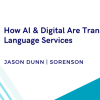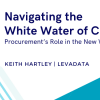Operational efficiency is on the radar for many CEOs and boards in 2018. The need to shorten decision-making time, bring in higher quality suppliers and keep on top of the latest innovation is part of the game we all play in procurement. This is particularly evident in the procurement of business services, an area of spend that hasn’t yet been optimised.
Looking within the wider world of all corporate buying, the procurement of goods is well-established in almost every sector. It has been analysed, evaluated, tested and refined to death. As a result, the market is saturated with proven solution providers for goods procurement. However, with an ever-tightening strategic focus on creating efficiencies, there is now a particular emphasis on tackling the specific process of purchasing business services to create an immediate impact to boost the bottom line.
The introduction of digitally-driven technologies and AI-based (artificial intelligence) algorithms have stimulated a new wave of outsourcing to support services procurement beyond some of the more established SaaS offerings that currently exist in many enterprises around the world. Through the recent adoption of modern procurement methods like crowdsourcing platforms, B2B marketplaces and online delivery platforms, pioneering corporate buyers are now able to streamline the way they buy business services and quickly tap into the latest innovation in their fields.
This is a timely arrival for this kind of augmented procurement, particularly with offshoring already viewed as an outdated outsourcing model by many companies who buy services externally. Corporate buyers are looking for more modern, consumer-friendly solutions to help them become more agile and efficient in their day jobs, while the very same tools also need to maintain buyer autonomy, ensure compliant buying practices and drive cost-savings. These corporate buyers are looking for solutions that can be implemented now—in the current year—and their consumer-driven mindset means that they are not willing to accept, nor do they need to accept, any delay in seeing immediate results.
So what is the hype all about? Are companies actually augmenting their procurement successfully and buying services differently? Is the shift in the corporate buying behaviour truly creating better results that address short-term, urgent deadlines? There does indeed appear to be a trend. Companies of all shapes and sizes are giving this modern approach to procuring services a try. They are seeing tangible results as well, to the tune of of 20- to 30-percent reductions in project budgets by simply adopting new approaches and behaviour in the corporate buying of business services.
The De’Longhi Group is a good example. This multinational company has always had complex marketing requirements due to its global footprint with direct commercial operations in 33 countries and products sold worldwide. The ability to access greater innovation is what drives De’Longhi to explore the new approach that B2B marketplaces offer to augment the corporate buying process.
The company regularly uses such a marketplace to source creative, advertising and marketing expertise. According to De’Longhi, this modern way of buying has opened up a completely new world of possibilities for accessing fresh ideas and innovation within its supply chain.
And that’s just one example. As part of an ongoing efficiency initiative, another well-known consumer brand is using enterprise crowdsourcing and B2B marketplaces to streamline the purchasing of services such as consulting, content creation, HR, event planning and travel from providers all over the world With initial trials now evolved into established programmes, the company confidently states that marketplaces drastically reduce the time and resources they need to source, vet and purchase business services, thereby making their lives a lot easier.
So, what makes all of this possible? What is the machine behind the scenes and what differentiates this from just another automated system that is attempting to modernise outsourcing? There is a clear distinction in my opinion: the idea of augmented procurement is that the choice is not a binary decision between “automate or don’t automate,” but rather a question of “where do I need to automate my buying process to be most efficient?”
Indeed, this question is at the core of every efficiency-driven activity, but we are in a decade when services procurement, in particular, is under the microscope to drive efficiency. As we all know, the corporate buying process for services will always require an element of human intervention in the decision-making process, so complete automation is unlikely for this kind of purchasing. Yet augmented procurement is here to stay when it comes to services procurement. It’s just a matter of seeing who will join the pioneers who are already reaping the benefits in their organisations and who will opt to follow in their shadows.






